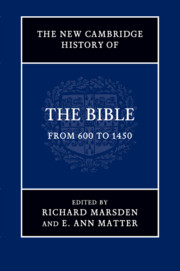Book contents
- Frontmatter
- Contents
- Figures
- Contributors
- Preface
- Abbreviations
- Abbreviations of books of the Bible
- Table of Psalm numbering
- Introduction
- Part I Texts and Versions
- Part II Format and Transmission
- 17 The Bibles of the Christian East
- 18 Carolingian Bibles
- 19 The Latin gospelbook, c. 600–1200
- 20 The Glossed Bible
- 21 The thirteenth century and the Paris Bible
- 22 Romanesque display Bibles
- 23 Latin and vernacular Apocalypses
- 24 The Latin psalter
- 25 Illustration in biblical manuscripts
- Part III The Bible Interpreted
- Part IV The Bible in Use
- Part V The Bible Transformed
- Bibliography
- Index of biblical manuscripts
- Index of scriptural sources
- General index
- References
18 - Carolingian Bibles
from Part II - Format and Transmission
Published online by Cambridge University Press: 28 May 2012
- Frontmatter
- Contents
- Figures
- Contributors
- Preface
- Abbreviations
- Abbreviations of books of the Bible
- Table of Psalm numbering
- Introduction
- Part I Texts and Versions
- Part II Format and Transmission
- 17 The Bibles of the Christian East
- 18 Carolingian Bibles
- 19 The Latin gospelbook, c. 600–1200
- 20 The Glossed Bible
- 21 The thirteenth century and the Paris Bible
- 22 Romanesque display Bibles
- 23 Latin and vernacular Apocalypses
- 24 The Latin psalter
- 25 Illustration in biblical manuscripts
- Part III The Bible Interpreted
- Part IV The Bible in Use
- Part V The Bible Transformed
- Bibliography
- Index of biblical manuscripts
- Index of scriptural sources
- General index
- References
Summary
In the first set of dedicatory verses composed by Audradus Modicus for the First Bible of Charles the Bald, Charles is reminded that the Bible ‘conveys what you love, what you should want to love, what it would be good to learn, what you should take up, believe in, and frequently do. It corrects, admonishes, repairs, chastises, dignifies, blames, implores, rebukes, adorns, nourishes. It brings together eloquence, morals, study and action; it is our sustenance, drink, rule, way, arms and salvation.’ Alcuin had described his recension of the Bible as ‘the fountain of life, the precepts of salvation which the saints wrote at God's dictation’. The Bible was considered to be the perfect source of instruction and of wisdom, and though works of Carolingian exegesis seldom achieved the popularity and influence of patristic commentaries, they were composed throughout the empire of Charlemagne (reigned 768–814), often originally as conferences on the text, sometimes at the request of rulers or bishops. This exegesis might include discussion of the biblical text, and it was accompanied by a concern with the correct text, shown in the collations (and occasionally recordings of variant readings) which were involved in the preparation of Carolingian Bible manuscripts.
Before the ninth century, Latin Bibles were most commonly copied in a series of volumes, though at Monkwearmouth–Jarrow the single-volume Codex grandior, made in the late sixth century for Cassiodorus, was imitated in the three great pandects copied for Abbot Ceolfrith. One of these has survived complete as the Codex Amiatinus, with 1,030 leaves and the text copied in two columns of 44 lines. The St Riquier library catalogue of 831 contained both a Bibliotheca integra ubi continentur libri LXXII in uno volumine and a Bibliotheca dispersa in voluminibus quattuordecim (‘a complete Bible where 72 books are contained in one volume’ and ‘a Bible divided into 14 volumes’). Most early biblical volumes were copied in uncials, though a seventh-century example (now a palimpsest) in the cathedral of León is a portion of a complete Bible in half-uncial, in two columns of some 72 lines, and there is a Merovingian cursive minuscule manuscript of the entire New Testament, which has escaped the attention of scholars (Paris, BNF, nouv. acq. lat 1063). Both books show that there were one- or two-volume Bibles before the Carolingian age, but in the course of the ninth century such pandects became much more common. Insular copies of biblical books were most commonly copied in Insular half-uncial or in Insular minuscule.
- Type
- Chapter
- Information
- The New Cambridge History of the Bible , pp. 325 - 337Publisher: Cambridge University PressPrint publication year: 2012
References
- 2
- Cited by

